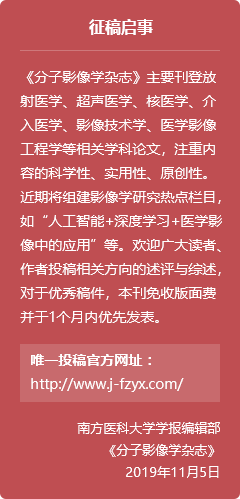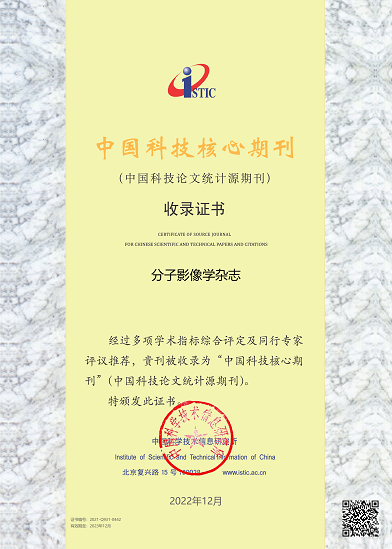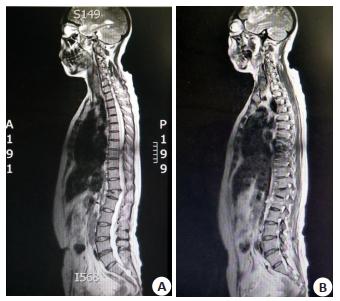Whole body diffusion-weighted imaging findings of multiple myeloma patients with different ISS stages and their correlation with prognosis
-
摘要:
目的探讨不同国际分期体系(ISS)分期多发性骨髓瘤患者磁共振全身扩散加权成像(WB-DWI)表现及其与预后的相关性。 方法选取2014年1月~2020年1月在我院治疗多发性骨髓瘤患者80例,其中ISS分期Ⅰ期19例,Ⅱ期28例,Ⅲ期33例,给予WB-DWI检查,分析不同ISS分期患者WB-DWI分型差异,以及不同WB-DWI分型患者预后情况。 结果ISS分期Ⅱ、Ⅲ期患者WB-DWI分型弥漫型和混合型总比例分别为82.14%和75.76%,高于ISS分期Ⅰ期患者(P < 0.05);ISS分期Ⅱ、Ⅲ期患者WBDWI分期弥漫型和混合型总比例差异无统计学意义(P>0.05);不同ISS分期患者病灶表观弥散系数值比较差异无统计学意义(P>0.05);WB-DWI分型弥漫型和混合型患者ISS分期与正常型患者比较差异有统计学意义(P < 0.05);B-DWI分型弥漫型和混合型患者血清β2微球蛋白高于正常型患者(P < 0.05);WB-DWI表现混合型患者中位总生存期(95%CI:19.73~24.27)短于正常型和弥漫型(95%CI:38.39~43.62,P < 0.05)。 结论不同ISS分期多发性骨髓瘤患者WB-DWI表现有所差异,WB-DWI表现与患者预后有一定关系。 -
关键词:
- 国际分期体系分期 /
- 多发性骨髓瘤 /
- 磁共振全身扩散加权成像 /
- 预后
Abstract:ObjectiveTo explore the whole body diffusion-weighted imaging(WB-DWI)findings of multiple myeloma patientswith different international staging system(ISS)stages and their correlation with prognosis. MethodsEighty patients withmultiple myeloma treated in our hospital from January 2014 to January 2020 were selected, including 19 patients with ISS stageI, 28 patients with ISS stage Ⅱ, and 33 patients with ISS stage Ⅲ.The WB-DWI was performed, the differences of WB-DWIclassification in patients with different ISS stages were analyzed, and the prognosis of patients with different WB-DWIclassification were analyzed. ResultsThe diffuse type and mixed type total proportion of WB-DWI in patients with ISS stage IIand Ⅲ were significantly higher than that in patients with ISS stage I(P < 0.05).The difference in the total proportion of diffusetype and mixed type of WB-DWI in patients with ISS stage Ⅱ and Ⅲ was not significant(P>0.05).There was no significantdifference in apparent diffusion coefficient between patients with different ISS stages(P>0.05).The difference in ISS stagesbetween patients with diffuse and mixed types and normal type of WB-DWI was significant(P < 0.05).The serum β2microglobulin of B-DWI patients with diffuse type and mixed type was significantly higher than that of normal type(P < 0.05).The median overall survival of mixed WB-DWI patients(95%CI: 19.73-24.27)was significantly shorter than that of normal anddiffuse types(95%CI: 38.39-43.62, P < 0.05). ConclusionThe WB-DWI findings of multiple myeloma patients with different ISSstages are different.There is a certain relationship between WB-DWI findings and prognosis. -
表 1 不同ISS分期患者临床一般资料比较
Table 1. Comparison of general clinical data of patients with different ISS stages (Mean±SD)
ISS分期 男/女 年龄(岁) BMI(kg/m2) Ⅰ期(n=19) 11/8 57.70±8.28 22.10±2.32 Ⅱ期(n=28) 16/12 58.13±9.04 22.01±2.83 Ⅲ期(n=33) 18/15 58.02±8.82 22.54±2.60 t/χ2 0.069 1.022 0.632 P 0.966 0.433 0.731 ISS:国际分期体系 表 2 不同ISS分期患者WB-DWI表现比较
Table 2. Comparison of WB-DWI findings of patients with different ISS stages[n(%)]
ISS分期 WB-DWI分型 χ2 P 正常型 弥漫型 混合型 Ⅰ期(n=19) 14(73.68) 3(15.79) 2(10.53) Ⅱ期(n=28) 5(17.86) 12(42.86) 11(39.29) 18.230 0.001 Ⅲ期(n=33) 8(24.24) 12(36.36) 13(39.39) WB-DWI:磁共振全身扩散加权成像 表 3 不同ISS分期患者病灶ADC值比较
Table 3. Comparison of ADC values of lesions in patients with different ISS stages (Mean±SD)
ISS分期 ADC值(×10-3 mm2/s) F P Ⅰ期(n=19) 0.90±0.16 Ⅱ期(n=28) 0.88±0.18 0.823 0.603 Ⅲ期(n=33) 0.91±0.15 表 4 不同WB-DWI表现患者临床资料比较
Table 4. Comparison of Clinical data of patients with different WB-DWI findings (Mean±SD)
临床资料 弥漫型和混合型(n=53) 正常型(n=27) t/χ2 P 性别[n(%)] 0.320 0.571 男 31(58.49) 14(51.85) 女 22(41.51) 13(48.15) 年龄(岁) 58.10±5.68 58.01±6.69 0.063 0.950 BM(I kg/m2) 22.24±2.65 22.35±2.81 -0.172 0.864 ISS分期[n(%)] 18.049 0.000 Ⅰ期 5(9.43) 14(51.85) Ⅱ期 23(43.40) 5(18.52) Ⅲ期 25(47.17) 8(29.63) β2-MG(mg/L) 4.10±1.04 2.98±1.00 4.613 0.000 血清肌酐(μmol/L) 78.28±13.32 80.02±11.43 -0.578 0.565 红细胞(×1012/L) 3.76±0.98 3.80±0.92 -0.176 0.861 血红蛋白(g/L) 110.59±9.28 113.39±10.02 -1.242 0.218 ADC值(×10-3 mm2/s) 0.89±0.10 0.92±0.11 -1.227 0.224 β2-MG:β2微球蛋白 -
[1] Bekiesinska-Figatowska M. MR imaging of multiple gestations[M]. Cham: Springer International Publishing, 2016: 231-43. [2] 房加高. 磁共振扩散加权成像序列的优化及其在多发性骨髓瘤诊断中的临床价值[D]. 南京: 南京医科大学, 2018: 11-12. [3] 郭成, 刘桂芳, 赵希鹏, 等. 探讨核磁共振全身扩散加权成像对多发性骨髓瘤的诊断价值[J]. 影像研究与医学应用, 2019, 3(18): 71-2. https://www.cnki.com.cn/Article/CJFDTOTAL-YXYY201918044.htm [4] 黄文阳, 杨咪, 隋伟薇, 等. 多发性骨髓瘤患者全身扩散加权成像的表现与临床检查结果的相关性[J]. 中华医学杂志, 2019, 6(9): 664-8. doi: 10.3760/cma.j.issn.0376-2491.2019.09.006 [5] 卢静, 张春阳, 杜鹃, 等. 新药时期国际分期体系(ISS)对中国多发性骨髓瘤患者的适用性研究[C]//第四届全国血液肿瘤学术大会暨第七届全国淋巴肿瘤诊治进展研讨会论文集. 武汉, 2014: 250-1. [6] 中国医师协会血液科医师分会, 中华医学会血液学分会, 中国医师协会多发性骨髓瘤专业委员会. 中国多发性骨髓瘤诊治指南(2015年修订[) J]. 中华内科杂志, 2015, 54(12): 1066-70. doi: 10.3760/cma.j.issn.0578-1426.2015.12.020 [7] 任进军, 韩书明, 赵宝宏, 等. 磁共振全身弥散加权成像诊断多发性骨髓瘤临床价值[J]. 临床荟萃, 2012, 27(17): 1535-7. https://www.cnki.com.cn/Article/CJFDTOTAL-LCFC201217032.htm [8] 何兰兰, 谢晓宝, 邱国强. 多发性骨髓瘤免疫标志联合国际分期系统分期对临床治疗及预后判断的意义[J]. 白血病·淋巴瘤, 2013, 22(1): 57-60. doi: 10.3760/cma.j.issn.1009-9921.2013.01.019 [9] San Pedro EC, Lorberboym M, Machac J, et al. Imaging of multiple bilateral parotid gland oncocytomas[J]. Clin Nucl Med, 1995, 20 (6): 515-8. doi: 10.1097/00003072-199506000-00010 [10] 章智敬, 郑文龙, 段伟民, 等. 多发性骨髓瘤磁共振全身弥散加权成像临床应用价值[J]. 温州医科大学学报, 2016, 46(11): 822-5. doi: 10.3969/j.issn.2095-9400.2016.11.008 [11] 钱晓丹, 姚爽玲, 管俊. 全身弥散加权成像在多发性骨髓瘤中的临床应用进展[J]. 实用临床医药杂志, 2020, 24(1): 19-23. https://www.cnki.com.cn/Article/CJFDTOTAL-XYZL202001005.htm [12] Lutsik NS, Mendeleeva LP, Solovev MV, et al. Whole-body magnetic resonance imaging for diagnosis and treatment monitoring in multiple myeloma[J]. Gematologiâ I Transfuziologiâ, 2020, 65(4): 431-43. doi: 10.35754/0234-5730-2020-65-4-431-443 [13] Narita K, Machida Y, Kuzume A, et al. Total diffusion volume estimated by whole-body diffusion magnetic resonance imaging for the assessment of tumor burden in multiple myeloma[J]. Blood, 2020, 136(Supplement 1): 1. [14] Minon M, Soriano C, Morland D, et al. Prospective comparison of whole-body MRI with diffusion-weighted and conventional imaging for the follow-up of neuroendocrine tumors[J]. Endocrine, 2020, 67 (1): 243-51. doi: 10.1007/s12020-019-02095-5 [15] González-Calle V, Slack A, Keane N, et al. Evaluation of Revised International Staging System (R-ISS) for transplant-eligible multiple myeloma patients[J]. Ann Hematol, 2018, 97(8): 1453-62. http://www.ncbi.nlm.nih.gov/pubmed/29623394 [16] Bezerra ROF, Recchimuzzi DZ, dos Santos Mota MM, et al. Wholebody magnetic resonance imaging in the oncology setting[J]. J Comput Assist Tomogr, 2019, 43(1): 66-75. doi: 10.1097/RCT.0000000000000772 [17] Kishimoto K, Tajima S, Maeda I, et al. Endometrial cancer: correlation of apparent diffusion coefficient (ADC) with tumor cellularity and tumor grade[J]. Acta Radiol, 2016, 57(8): 1021-8. doi: 10.1177/0284185115612249 [18] 邓书会, 徐燕, 麦玉洁, 等. 112例多发性骨髓瘤患者ISS分期分析及与DS分期、IFM分期的比较[J]. 中华血液学杂志, 2008, 17(4): 217- 21. doi: 10.3321/j.issn:0253-2727.2008.04.001 [19] Latifoltojar A, Humphries PD, Menezes LJ, et al. Whole-body magnetic resonance imaging in paediatric Hodgkin lymphoma - evaluation of quantitative magnetic resonance metrics for nodal staging[J]. Pediatr Radiol, 2019, 49(10): 1285-98. doi: 10.1007/s00247-019-04463-9 [20] Mangiacavalli S, Michela Z, Ferretti VV, et al. Whole body diffusion weighted MRI (WB DWI) for the management of multiple myeloma: high concordance between MRI diffuse pattern and BONE marrow plasma CELL infiltration RATE[J]. Blood, 2019, 134(Supplement_1): 5495. doi: 10.1182/blood-2019-126422 -







 下载:
下载:



